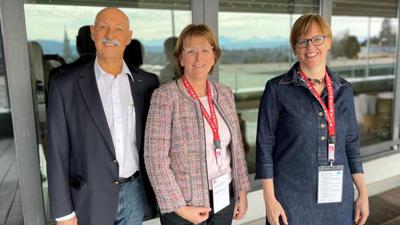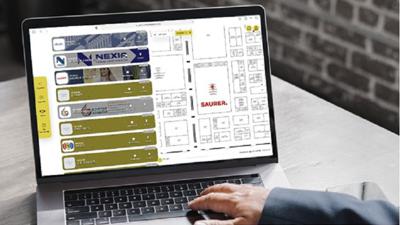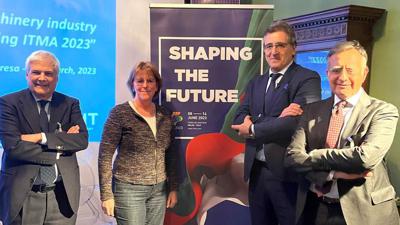Melliand International 2/2023

Charles Beauduin (Source: ITMA)
Digitalization and sustainability are hand-in-hand driving the development of new technologies and leading to an environment of continuous improvement for textile machinery companies, and consequently for the textile industry. Such novel technologies will feature prominently at the ITMA exhibition to be held in Milan/Italy from June 8-14, 2023.
Big data: The benefits of digitalization in textile production now span developments from in-plant progress in areas such as advanced fault detection and routine maintenance to the control of entire smart factories and beyond. Big data ‘off-the-shelf’ systems such as those behind technologies like facial recognition and Google Maps are being specifically tailored to machine learning solutions in order to elevate the fault detection process and the accuracy of naming and grading subtle defects in textiles – in real time within production environments. A latest development is in the ability to accurately detect even the most subtle of defects in patterned fabrics. The challenge here has been that fabrics are not rigid and can be creased or stretched and are also subject to local distortion, which leads to thousands of false positives in detection. Sophisticated software for pattern inspection, however, is now ensuring a clean image and allowing the detection of the faults in patterned fabrics running at speeds of up to 100 m/min.
In sync: Meanwhile, smart factory production machines are now increasingly talking to each other and making a lot of new features possible, such as real-time monitoring and automatically triggering corrections based on historic data that can instantaneously adapt in real time. More than anything, digitalization is about increasing the optimal flow of an entire plant, and increasingly, networks of plants operating in sync around the world. Additive printing is another useful technology being used by machine builders to rapidly create part prototypes, increasingly enabling agile collaborations between different production units; it also allows flexible and personalized designs previously not possible. Added to this is the use of embedded informatics for the different production units and the integration of collaborative robots being integrated into manufacturing networks. Sensors embedded on machines for data acquisition further enhance machine and product monitoring and communication within textile manufacturing plants, and predictive maintenance can optimize schedules and reduce costs, with augmented reality supporting operators during maintenance. Cloud computing and big data analytics enable the collection and processing of a considerable amount of information coming from the production machines. Improved planning and monitoring, process and product traceability and preventive and predictive maintenance now result from this available data. The development of entirely new materials in the field of printed electronics is also emerging via digital printing – a field that is gaining traction rapidly for its ability to produce low-cost long runs with a far lower ecological footprint compared to traditional electronics production. The field of printed biosensors, in particular, has gained a lot of attention in recent years.
Go for green: Under pressure to adopt earth-friendly practices, the textile world has begun to reinvent itself in innovative ways. There is fast-paced innovation for fiber-to-fiber recycling to turn textile waste into new fibers that are then used to create new clothes or other textile products. The growing emphasis on circular supply chains and new technologies has put the spotlight on chemical recycling routes and full materials recovery, along with digitalized separation and sorting. Big advances are being made in the processes for dyeing, finishing and coating – traditionally the most resource-intensive sectors of textile production in terms of water, energy, dyes and chemicals. A number of ITMA 2023 exhibitors will be displaying commercial non-contact spray application technologies for these processes that offer tremendous savings. Textile manufacturers apply only the required amount of dye or chemical finish to the fabric surfaces, thanks to the precision made possible by the latest sensor-based control systems. Completely water-free dyeing units are also now becoming commercially available, with reclaimed CO2 replacing water as the dyeing medium in some closed-loop processes. When heated and pressurized, CO2 becomes supercritical – a phase between a liquid and a gas. In this state, dyes can dissolve easily and deeply into fibers, creating vibrant colors. This technology has already been adopted by suppliers to major brands such as adidas, IKEA and Nike. At the ITMA 2023, a host of recycling solutions will be showcased, from textile recycling equipment to wastewater treatment equipment, heat recovery systems, waste management and pollution prevention equipment, and more.
Energy costs: In 2022 and going into 2023, escalating energy costs have increasingly put pressure on the textile industry and its supply chain, but even this additional difficulty is sparking innovation. At the ITMA 2023, it will become apparent that, difficult as they have proved, the hike in energy prices has further driven the development of innovative new technologies, in close consultation with customers. When Covid-19 made travelling impossible, for example, many machine builders adopted new remote assistance tools, developed their own in-house software and even established committed design departments. This experience really enhanced the many services textile machinery builders can now provide, as will be very evident at ITMA 2023.
As the world’s largest international textile and garment technology exhibition, the ITMA 2023 will be a hub of innovation where visitors can source the latest technologies and solutions from over 1,600 exhibitors that will help transform their business. Participants should also find time to explore the new Start-Up Valley to spark their transformative journey towards a digital and sustainable future.
Charles Beauduin
Chairman
ITMA Services
Chairman
ITMA Services



